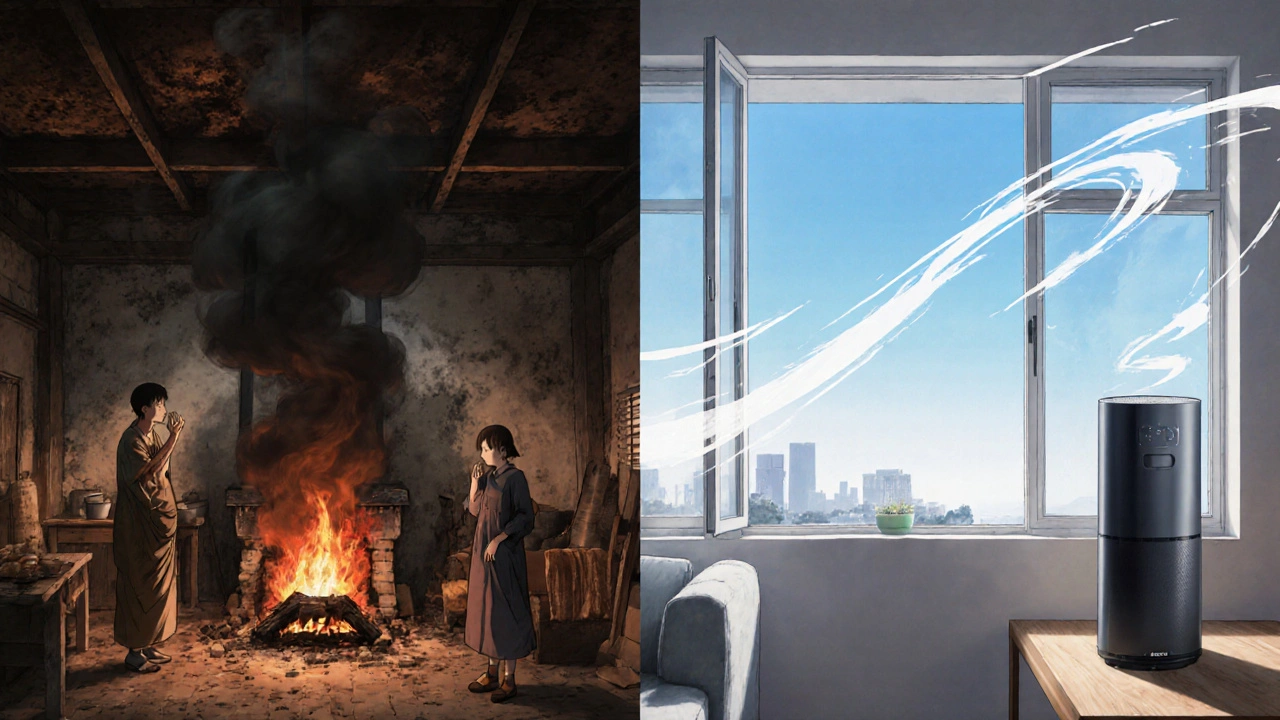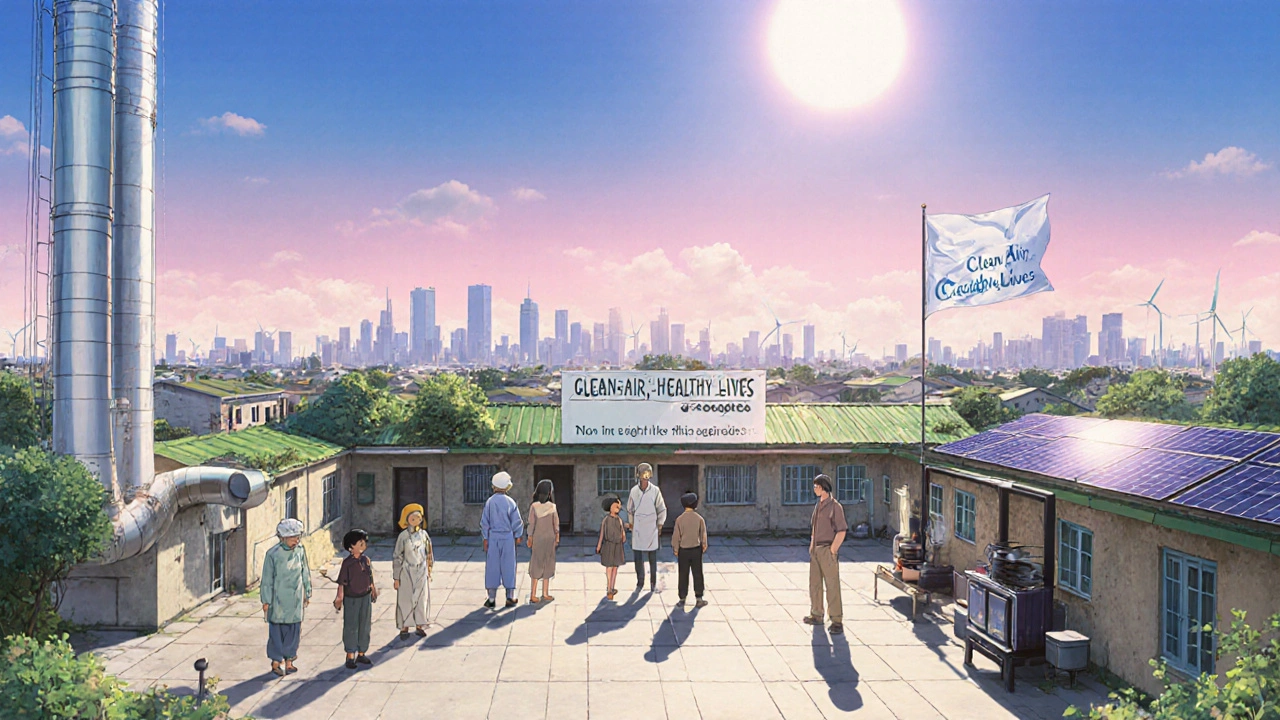TB Ventilation Risk Calculator
How Ventilation Affects TB Transmission
The World Health Organization recommends at least 12 L/s per person for reducing TB transmission. Poor ventilation increases the reproductive number (R₀) from 0.5 to over 2.0 in crowded spaces.
Calculate Your Risk Reduction
Results will appear here
When you hear the word Tuberculosis is a contagious bacterial disease caused by Mycobacterium tuberculosis that primarily attacks the lungs, you probably think of coughs, antibiotics, and vaccination campaigns. What many people miss is that the places we live, work, and breathe play a huge role in how the disease spreads and how severe it becomes. In this article we break down the hidden link between the environment and tuberculosis, show which factors matter most, and give clear actions you can take whether you’re a homeowner, a public‑health worker, or a policy maker.
Key Takeaways
- Air quality, indoor ventilation, and crowding are the top environmental drivers of TB transmission.
- Smokers, people living with HIV, and those who are under‑nourished face higher risks when environmental hazards are present.
- Simple steps like improving airflow, using air‑purifying filters, and reducing indoor smoke can cut TB infection rates by up to 30% in high‑risk settings.
- Climate‑related changes such as hotter, more humid seasons can expand the geographic range of TB.
- Public policies that address housing quality and air‑pollution standards are as vital as medical treatment.
How the Environment Shapes TB Transmission
The bacterium Mycobacterium tuberculosis thrives in tiny aerosol droplets that linger in the air for hours. When someone with active lung TB coughs, speaks, or sings, they release particles that can travel meters in still air. The farther those particles travel before settling, the more people they can reach. Factors that keep droplets suspended-poor ventilation, high humidity, and stagnant indoor air-directly raise the chance that a bystander inhales an infectious dose.
Scientists have measured the “reproductive number” (R₀) of TB in well‑ventilated clinics at around 0.5, meaning each case infects half a person on average. In cramped, poorly ventilated wards the same pathogen can push R₀ above 2, turning a manageable outbreak into a runaway epidemic.
Air Quality and TB
Outdoor air pollution isn’t just a heart‑disease problem; it also weakens the lungs’ natural defenses. Fine particulate matter (PM2.5) and nitrogen dioxide (NO₂) cause chronic inflammation, making it easier for Air pollution to impair macrophage function, the cells that usually trap and destroy TB bacteria.
One Indian cohort study followed 5,000 adults for eight years and found that each 10 µg/m³ increase in PM2.5 raised TB incidence by 15 %. The effect was strongest among smokers and people living in households that used solid fuels for cooking.
Indoor air quality matters even more. Kitchens that rely on open‑fire stoves release copious smoke, carbon monoxide, and soot. In rural sub‑Saharan Africa, households using biomass fuel reported TB rates 2.3 times higher than those with clean‑fuel stoves.

Ventilation, Overcrowding, and Urban Living
Modern cities pack people together in apartments, dormitories, and transport hubs. When the average floor‑area‑per‑person drops below 10 m², airborne diseases flourish. Overcrowding raises the concentration of infectious droplets while reducing the distance they need to travel.
Two landmark studies from China compared university dorms with ventilation rates of 1.5 L/s per person to dorms with 6 L/s. The low‑ventilation group saw a three‑fold rise in latent TB conversion over a single academic year.
Urbanization also brings humidity and temperature shifts that affect droplet survival. Warm, humid environments keep droplets moist longer, extending the bacteria’s viability.
Climate Change and Shifting TB Patterns
Rising global temperatures alter where TB can thrive. Warmer climates expand the geographic range of Mycobacterium tuberculosis, especially in regions where previously low humidity limited airborne spread.
Modeling from the World Health Organization predicts that by 2050, climate‑related migration could add 1.5 million new TB cases annually, concentrated in slums of megacities that lack adequate housing.
Extreme weather events-floods, hurricanes, wildfires-disrupt health services and force people into temporary shelters, where ventilation is often poor and crowding is high. The 2023 wildfire season in the western United States saw a spike in TB diagnoses among evacuees living in emergency housing.
Co‑Risk Factors Tied to the Environment
Smoking, HIV infection, and malnutrition each amplify the impact of environmental hazards on TB.
Smoking damages cilia, the tiny hairs that clear debris from the airway, and reduces immune response. A meta‑analysis of 25 studies showed smokers exposed to indoor smoke had a 2.9‑fold higher risk of active TB compared to non‑smokers in the same household.
HIV infection weakens the cellular immunity needed to contain TB bacteria. In regions with high HIV prevalence, even modest air‑pollution levels double the likelihood of progressing from latent to active TB.
Malnutrition reduces the body’s ability to produce the immune cells that fight TB. Children who are under‑weight and live in homes with indoor coal stoves face a combined risk that is five times higher than well‑nourished peers in clean‑fuel homes.

Practical Steps to Reduce Environmental TB Risk
- Boost ventilation. Open windows daily, install exhaust fans in kitchens and bathrooms, and consider mechanical ventilation systems that provide at least 12 L/s per person in communal spaces.
- Use air‑purifying filters. HEPA filters capture particles down to 0.3 µm, well below the size of TB droplets. Place them in high‑traffic rooms like living rooms and classrooms.
- Switch to clean cooking fuels. LPG, electric induction, or solar cookers eliminate indoor smoke and cut PM2.5 exposure by up to 80 %.
- Reduce indoor smoking. Designate smoke‑free zones, provide cessation programs, and enforce bans in public housing.
- Improve housing standards. Seal cracks that allow dust ingress, insulate to control humidity, and avoid overcrowding by enforcing minimum floor‑area guidelines.
- Integrate health screening with housing programs. Offer TB testing in shelters, low‑income housing complexes, and during climate‑disaster relocations.
- Support policies. Advocate for stricter air‑quality standards, subsidies for clean‑fuel stoves, and funding for ventilation upgrades in schools and clinics.
When communities adopt even a few of these measures, local health departments report measurable drops in TB case numbers within a year.
Frequently Asked Questions
Can outdoor air pollution really affect TB risk?
Yes. Fine particles and gaseous pollutants weaken lung defenses, making it easier for inhaled TB bacteria to establish infection. Studies from India and China consistently show higher TB incidence in regions with elevated PM2.5 levels.
How much ventilation is enough to lower transmission?
Guidelines recommend at least 12 L/s per person in crowded indoor settings. Simple actions like keeping windows open for 15‑30 minutes each hour can reach that target in most homes.
Do HEPA filters actually capture TB bacteria?
HEPA filters capture particles as small as 0.3 µm with 99.97 % efficiency. TB droplets are larger than that, so a properly sized HEPA unit can significantly reduce airborne bacterial load.
Is climate change expected to increase TB cases worldwide?
Projections from the WHO suggest that rising temperatures and increased migration could add 1‑2 million new cases per year by 2050, especially in rapidly expanding urban slums.
What role do HIV and malnutrition play in environmental TB risk?
Both conditions weaken the immune system, so exposure to polluted air or indoor smoke has a magnified effect. In high‑HIV settings, even modest indoor pollution can double the chance of active TB.
Putting It All Together
The link between Environment and tuberculosis isn’t a vague idea; it’s a measurable driver of disease that can be altered with concrete actions. By cleaning the air we breathe, designing homes that let fresh air flow, and tackling the social factors that force people into crowded, smoky spaces, we give medical treatment a fighting chance to work.
Whether you’re a homeowner adjusting a window, a clinic manager installing a ventilation system, or a policy maker drafting air‑quality regulations, the steps outlined here move the needle. The surprising connection becomes a powerful lever for saving lives.


5 Comments
October 21, 2025 eric smith
Oh great, another brilliant piece telling us that fresh air is somehow a miracle cure for tuberculosis. As if we didn’t already know that opening a window is the secret to eradicating a disease that has killed millions. The article rattles off stats about PM2.5 and R₀ like a schoolkid reciting their math homework, yet it completely glosses over the fact that most low‑income neighborhoods can’t afford HEPA filters or even reliable electricity. Sure, you can "boost ventilation" by cracking a pane, but good luck when the building is a concrete bunker designed to keep heat out, not germs out. And let’s not forget that the suggested 12 L/s per person is a luxury in cramped dorms where space is measured in square feet, not liters. The nice‑to‑have recommendations about LPG stoves ignore that many families rely on firewood because it’s the only thing they can afford. It’s cute that the article mentions climate change, as if the impending heat waves will magically motivate policymakers to upgrade slum housing. Meanwhile, the real culprits-corporate interests pushing cheap, polluting fuels-stay untouched. If we wanted a real solution, we’d start by regulating the sale of solid‑fuel stoves, not just posting a checklist for homeowners. Also, the notion that a simple air filter can slash infection rates by 30 % sounds more like marketing hype than science. Yes, HEPA filters catch particles, but they don’t fix the underlying poverty that forces families into poorly ventilated shacks. And let’s be honest, most TB patients are dealing with HIV, malnutrition, and a lack of access to proper medical care-air quality is just one piece of a massive puzzle. The article’s optimism is refreshing, if you enjoy reading wish‑fulfillment pieces while the world burns. So, kudos for the effort, but next time try addressing the socioeconomic root causes instead of handing out DIY tips like candy.
November 2, 2025 parbat parbatzapada
i read the whole thing and kinda felt like they were hiding stuff behind big words. like they keep saying "co‑risk" and "latent conversion" but never admit that maybe the real danger is the big pharma companies that profit from TB meds. also, the whole "open windows" advice is a joke when you live in a dusty city where the air outside is full of smoke from traffic and burning trash. i get why they want us to think it’s just about ventilation, but it feels like a distraction from the fact that our governments don’t care about the slums. i’ve seen families using the same smoky stove for generations, and they’re told to just switch fuels – as if that’s easier than affording a new stove. crazy how we’re told to clean up the air while the real pollutants are the policies that keep us poor.
November 13, 2025 Casey Cloud
actually the data on ventilation is solid you can see it in the china dorm study the key is to get at least 5‑6 l/s per person in schools and clinics that can cut transmission by a third it also helps to use simple exhaust fans in kitchens they cost less than 50 dollars and are easy to install the filter recommendation is also realistic if you buy a unit that fits the room size you’ll capture most of the droplet particles keeping the indoor air cleaner overall these steps are doable even in low budget settings if you combine them with regular TB screening you’ll see a drop in case numbers within a year
November 24, 2025 Rachel Valderrama
Sure, just open a window and solve everything. 🙄
December 6, 2025 Kathrynne Krause
Folks, let’s turn this knowledge into action! 🌎💨 Imagine neighborhoods humming with fresh breezes, kitchens glowing with clean‑fuel stoves, and schools breathing easy thanks to proper vents. It’s not a fantasy – it’s a vibrant future we can build together. Think of the kids laughing in classrooms where the air is crisp, the elders sipping tea without coughs, and doctors finally catching a break because the environment isn’t feeding the bacteria. Let’s rally our communities, push for policy that funds ventilation upgrades, and swap out those smoky chulhas for sleek, low‑emission ovens. Every open window, every air‑purifier unit, every clean‑fuel stove is a tiny victory in the war against TB. Keep the momentum alive, share these tips, and watch the ripple effect grow. Together, we can rewrite the story of TB from tragedy to triumph! 🚀
Write a comment